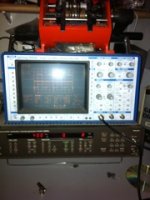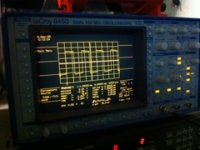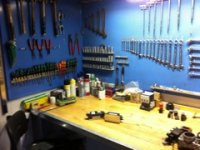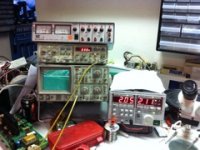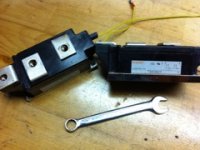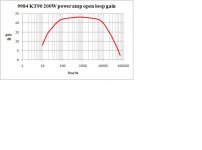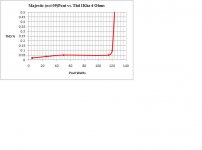OK, I think you have convinced us that safety will not be an issue, but safety is not the only issue. If you simply want a 300W valve amp then go and buy one. If you want to understand, design and build a 300W valve amp then my advice is still to start small. Otherwise you are likely to be back here in a few weeks/months saying "I built it but it hums/oscillates/destroys fuses/valves/speakers" or whatever.
Handsome workshop !
Concerning your test equipment, for me there are two devices over the others, namely good audio analyzer and low distortion audio source.
I could not eveluate my designs and projects without these.
With oscilloscope one can only check that the operation is roughly where it should. (this concerns hifi amps.)
Concerning your test equipment, for me there are two devices over the others, namely good audio analyzer and low distortion audio source.
I could not eveluate my designs and projects without these.
With oscilloscope one can only check that the operation is roughly where it should. (this concerns hifi amps.)
Handsome workshop !
I could not eveluate my designs and projects without these.
With oscilloscope one can only check that the operation is roughly where it should. (this concerns hifi amps.)
If you know your oscilloscope and the math behind it as was the case in the early days, with it you can check the condition of the whole amp. For many years I did this when cash was short for other gear. By chance, phase and damping response are my measuring prime apps. Use the graticule !
richy
Nice fat IGBTs whatever they are. I am currently on a build of a 400A TIG welder using such devices.
My amp at the moment is built on wood planks. It has 630V ac and almost 1KV between points. It is nothing compared to what you are thinking of.
I work in inverter drives and high power electronics. Much like you and I bet our CVs read the same, I had the thought of a massive valve amp. It is a steeper learning curve then you think.
The learning curve is the most enjoyable bit. Plus in my case getting the test equipement.
Big valve amps are expensive. You can do it though.
My little set up with 807ish tubes is giving out 160WRMS per channel. I only use about 4W of this so it really is a waste. Its good to blow my friends away with very high quality audio though...........
Back to the point, you need to evaluate how much power you need. My speakers are bad effiency wise, so I need heaps. Thing is as I have already said I use on average 4W. The rest is just head room and I am sure you know the logarithmic rule.
Read, experiment, read some more and get it right dude.
Cheers Matt.
My amp at the moment is built on wood planks. It has 630V ac and almost 1KV between points. It is nothing compared to what you are thinking of.
I work in inverter drives and high power electronics. Much like you and I bet our CVs read the same, I had the thought of a massive valve amp. It is a steeper learning curve then you think.
The learning curve is the most enjoyable bit. Plus in my case getting the test equipement.
Big valve amps are expensive. You can do it though.
My little set up with 807ish tubes is giving out 160WRMS per channel. I only use about 4W of this so it really is a waste. Its good to blow my friends away with very high quality audio though...........
Back to the point, you need to evaluate how much power you need. My speakers are bad effiency wise, so I need heaps. Thing is as I have already said I use on average 4W. The rest is just head room and I am sure you know the logarithmic rule.
Read, experiment, read some more and get it right dude.
Cheers Matt.
Hi All
Thanks for all input
Right now i am extremely busy at work, came home after 15 hours work
Well... as it is right now, I am considering "The Beast", however I think it is expensive in tubes especially if i am going to run it hot, to get the 250W out of it.
Well Bye for now, i Will be back !
PS: I will be back with a commen to you Matt.B.H.
Best Regards Allan
Thanks for all input
Right now i am extremely busy at work, came home after 15 hours work
Well... as it is right now, I am considering "The Beast", however I think it is expensive in tubes especially if i am going to run it hot, to get the 250W out of it.
Well Bye for now, i Will be back !
PS: I will be back with a commen to you Matt.B.H.
Best Regards Allan
Hi 
Well what about this one ? KT88 PP5
I know that it is old but, if any one in her have heard this amp, i wold like to know how i sound ?
Any one know the frequency response on that and distortion with and with out load.
My thought was, take out one KT 88 in each side and use the HAMMOND (1650W 280 1,900 C.T. Push-Pull Par. (6 or 8 Tubes) 6L6GC, 5881, EL34, 6550B, KT88)
http://www.tube-town.net/info/hammond/hammond_ot_pp_classic.pdf
output transformator, but there is nothing about the global feed back, beside that it is shown where to place it.
Do anyone have a opinion about this schematic ?
Well what about this one ? KT88 PP5
I know that it is old but, if any one in her have heard this amp, i wold like to know how i sound ?
Any one know the frequency response on that and distortion with and with out load.
My thought was, take out one KT 88 in each side and use the HAMMOND (1650W 280 1,900 C.T. Push-Pull Par. (6 or 8 Tubes) 6L6GC, 5881, EL34, 6550B, KT88)
http://www.tube-town.net/info/hammond/hammond_ot_pp_classic.pdf
output transformator, but there is nothing about the global feed back, beside that it is shown where to place it.
Do anyone have a opinion about this schematic ?
Hi Matt.B.H. 
yes we share the same work, my specialty is ABB drive in generla, DCS 500 (DC DRIVE), ACS 800 and the ACS M1 Servo drive.
I am more likely to parallel connecting the tube and whit a higer bias power, my B+ supply about 500 - 550 VDC. but I am still dreaming.
The fat moduel on the table is a dual thyristor it is from fasse kompensation in a win turbine and it is 3800 VDC @ 240 Amp 800 Amp rms
It sounds to be a sweet tube amp, you have built yourself and well big compared to what you need.
It sound like your tube amp is running in idle, when I finish with my tube amp, I will assure you of my neighbors also have good music to hear : P
you can never get enough watts
Best regards Allan
yes we share the same work, my specialty is ABB drive in generla, DCS 500 (DC DRIVE), ACS 800 and the ACS M1 Servo drive.
I am more likely to parallel connecting the tube and whit a higer bias power, my B+ supply about 500 - 550 VDC. but I am still dreaming.
The fat moduel on the table is a dual thyristor it is from fasse kompensation in a win turbine and it is 3800 VDC @ 240 Amp 800 Amp rms
It sounds to be a sweet tube amp, you have built yourself and well big compared to what you need.
It sound like your tube amp is running in idle, when I finish with my tube amp, I will assure you of my neighbors also have good music to hear : P
you can never get enough watts
Best regards Allan
Hi, Hoej,
There are few designs you can consider.
1) Several McIntosh amps, like MC3500 or K-107, MI-200AB (type K-107).
2) Amp designed by Bob Carver, which uses several KT88.
3) Denon once manufactured tube amp with output power 100W. By means of using 4 output tubes instead of 2, you can get 200W.
4) Sansui also had 100W tube amp, see receipt above.
There are few designs you can consider.
1) Several McIntosh amps, like MC3500 or K-107, MI-200AB (type K-107).
2) Amp designed by Bob Carver, which uses several KT88.
3) Denon once manufactured tube amp with output power 100W. By means of using 4 output tubes instead of 2, you can get 200W.
4) Sansui also had 100W tube amp, see receipt above.
Hi Matt.B.H.
I am more likely to parallel connecting the tube and whit a higer bias power, my B+ supply about 500 - 550 VDC. but I am still dreaming.
Best regards Allan
Now the reality..
Don't forget the power supply.... 500V upwards for smoothing is awkward. Two large series electroytics takes up more space and placed avoiding the heat. Unless ABB stocks 600V electroytics.
One of the amp design problems I encounted going above 200W was the limitations of the E&I constructed output transformer become serious and the one I specified to the winder has 14 sections, same as my 150W versions but it behaves different. Bigger core, nearly x2 higher coupling capacitances between windings just ruins the top end performance and forcing the issue with higher tube B+ and quiescent current on a power test simply destroys the snubber caps & resistors. No-way will I use a 10W resistor for a nubber.
Disappointed, I returned to the E&I 150W lump, with parallel o/p paired tubes same A-A & UL specs and I get the results I am after.
Back to 200W lump see open loop gain pic. In this case, the driver and phasesplitter circuitry drooped at -3dB at 300Khz, way above audio b/w and 1st stage zobel trimming had to be slewed right down to suit the o/p transformer and bode plot. It didn't look good. Global nfb set around 22dB reduces thd around 0.25% at 1Khz rising to 1% at 10Khz due to the higher interwinding capacitances; one starts to run into o/p transformer response restrictions making hard work at 20Khz. The solution was to use a 150W tranny that can be pushed above 200W resulting in a 45Khz b/w giving 0.35% thd at 10Khz...(big reduction in interwinding capacitance compared to previous)... and into upper bass without overdriving the output tubes. As I do keyboard work with an octave shifter I also built in a HP filter, -3dB at 25Hz to avoid overload. OM decision. The LF end was better, designing the time constants and optimising the transient response gave 15dB global at 20Hz which was reasonable.
Parallel push pull windings are usually more generously rated for current than for single pairs and can be pushed that bit more..
In the end after alot of midnight oil, I found it notoriously hard to optimise the square wave response with a true 200W core only by hard slewing which consumes vital power, ruin sound definition and not worth using top notch tubes.
If you aren't critical about quality then it doesn't matter, but my amps end up in open air where they get heard.
It is quite possible that a Plitron toroidal may offer a better solution, but the improved bandwidth will create an excellent RF oscillator should instability result......More troubles.
Keep to a design that others have mentioned. For real !!
richy
Attachments
I am surprised that nobody has pressed you a little harder on your design goals. You stated you wanted 250 Watts to drive your speakers. Looking at the specs on those, they are 90 dB 1 Watt 1 metre speakers. You say you want tube power, but why? I am guessing because you want 'tube sound'? One of the characteristics of many tube amp designs is that they tend to clip much more benignly. The advantage of this is that you do not require the headroom in most tube amps that you would require in a solid state amp.
For example, I am using a 25-30 watt amp with my 93 dB efficient speakers. This would be the equivalent of 50-60 watts in to your speakers. 256 watts = 114 dB with your speakers. At that sound pressure level, do you think you are going to be able to discriminate between tube sound and solid state?
Very high power tube amp = very expensive and very complicated. I would suggest that a sub-100 watt amp is going to be adequate to drive your speakers, and probably sound better than a poorly implemented complex high power amp, especially so if it is your first tube amp effort.
You mentioned Hammond output transformers. If you accept lower output power, you could widen your horizons to include higher quality output transformers.
If it were me, I would focus on quality rather than power. If the driving requirement is high sound pressure level through high amplifier output power, just go solid state.
Cheers,
Chris
For example, I am using a 25-30 watt amp with my 93 dB efficient speakers. This would be the equivalent of 50-60 watts in to your speakers. 256 watts = 114 dB with your speakers. At that sound pressure level, do you think you are going to be able to discriminate between tube sound and solid state?
Very high power tube amp = very expensive and very complicated. I would suggest that a sub-100 watt amp is going to be adequate to drive your speakers, and probably sound better than a poorly implemented complex high power amp, especially so if it is your first tube amp effort.
You mentioned Hammond output transformers. If you accept lower output power, you could widen your horizons to include higher quality output transformers.
If it were me, I would focus on quality rather than power. If the driving requirement is high sound pressure level through high amplifier output power, just go solid state.
Cheers,
Chris
Hi All ...
First thanks for your input, it is obviously important to listen to all you experienced enthusiasts, not to commit stupid mistake which might end up with a product that is crap.
I have spent much time reading here and elsewhere and is beginning to come to the conclusion that it is not really possible to have high effect that I want.
The reason for the high power is that I sometimes play pretty loud.
I fully agree that one possibly can not hear the difference on a solid state and a tube amplifier at full output 250W.
That has put me in a dilemma now I have to choose .......
I can build a tube amplifier with 150W and buy a hearing aid and there by increasing the sound levels by 3 db or moor lol (bad joke)
No. .... I am of course going for the quality and it seems that there is many more tube amp to choose between up to 150 W
Yes, I can see problem post with a low B + voltage points taken.
If i should build a tube amplifier in the range of 100 - 150W maybe Class A, what would you choose!
PS: If you think I'm a little slow to respond and sometimes the context isn't quite hanging together. There is a reason for that, i am what you might call dyslexic in some degree, which means it takes me pretty long to read a thread through, and it is even worse when i write, however I speak, fluent English
Bedst Regards Allan
First thanks for your input, it is obviously important to listen to all you experienced enthusiasts, not to commit stupid mistake which might end up with a product that is crap.
I have spent much time reading here and elsewhere and is beginning to come to the conclusion that it is not really possible to have high effect that I want.
The reason for the high power is that I sometimes play pretty loud.
I fully agree that one possibly can not hear the difference on a solid state and a tube amplifier at full output 250W.
That has put me in a dilemma now I have to choose .......
I can build a tube amplifier with 150W and buy a hearing aid and there by increasing the sound levels by 3 db or moor lol (bad joke)
No. .... I am of course going for the quality and it seems that there is many more tube amp to choose between up to 150 W
Yes, I can see problem post with a low B + voltage points taken.
If i should build a tube amplifier in the range of 100 - 150W maybe Class A, what would you choose!
PS: If you think I'm a little slow to respond and sometimes the context isn't quite hanging together. There is a reason for that, i am what you might call dyslexic in some degree, which means it takes me pretty long to read a thread through, and it is even worse when i write, however I speak, fluent English
Bedst Regards Allan
If you really intend to listen at 115dB levels you will probably end up having a hearing aid on hand anyway.  Another option if you really need gunshot level SPLs is to bi-amp. Above a couple hundred Hz the power level requirements are much less. You could use class A PP on top and class AB PP or solid state on the bottom. If you are going to do it all with one amp instead of bi-amping I would suggest going class AB and just be careful about the biasing to get the best results.
Another option if you really need gunshot level SPLs is to bi-amp. Above a couple hundred Hz the power level requirements are much less. You could use class A PP on top and class AB PP or solid state on the bottom. If you are going to do it all with one amp instead of bi-amping I would suggest going class AB and just be careful about the biasing to get the best results.
Hello*mashaffer
I have been considering*to*split*my*JBL*L220.*but I*have not*been*able to*find anything*about*the*Crossover frequency.**
Crossover*filter*is*quite extensive*and*what*happens to the*phase*when*I start*to*mess*around*med*it*and*how*can*I*verify*that*the phase is*properly*afterwards.
I*have*looked at*various solutions,*for which*tube*amp*I*could*choose from.*There*has been*suggested*"The*Beast"and*have*found*M125
The*Beast*have*16*tubes*in*output state*and*there for*scared*that one or more tube will go bat on me, and i have*not ben able to find*the frequency*span*or*distortion or any data at all.
M125*I do not know*if I*can split*up*my purchase,*so : no*box,*power*transformer*or*tube.
I've*actually asked for a price*of*shipping,*I almost dropped my*mac*on the*floor. *500, -*$*for*shipping*to*DK
But I*know*a*few*in*the U.S.*and*maybe i*can*get*them*to*send*it*to*me.
but*which*one*of*the amplifiers*would you*choose?
Transcendent Sound BEAST OTL Tube Amp
tubes4hifi amplifier KITs page
Prototype 125 watt monoblock tube amplifier KIT - Page 7
# POST 102
I have been considering*to*split*my*JBL*L220.*but I*have not*been*able to*find anything*about*the*Crossover frequency.**
Crossover*filter*is*quite extensive*and*what*happens to the*phase*when*I start*to*mess*around*med*it*and*how*can*I*verify*that*the phase is*properly*afterwards.
I*have*looked at*various solutions,*for which*tube*amp*I*could*choose from.*There*has been*suggested*"The*Beast"and*have*found*M125
The*Beast*have*16*tubes*in*output state*and*there for*scared*that one or more tube will go bat on me, and i have*not ben able to find*the frequency*span*or*distortion or any data at all.
M125*I do not know*if I*can split*up*my purchase,*so : no*box,*power*transformer*or*tube.
I've*actually asked for a price*of*shipping,*I almost dropped my*mac*on the*floor. *500, -*$*for*shipping*to*DK
But I*know*a*few*in*the U.S.*and*maybe i*can*get*them*to*send*it*to*me.
but*which*one*of*the amplifiers*would you*choose?
Transcendent Sound BEAST OTL Tube Amp
tubes4hifi amplifier KITs page
Prototype 125 watt monoblock tube amplifier KIT - Page 7
# POST 102
Sorry about all the * do not know what went wrong
one more
http://www.triodeguy.com/Triodeguy PDF files/Triodeguy kt88aud.pdf
one more
http://www.triodeguy.com/Triodeguy PDF files/Triodeguy kt88aud.pdf
Maybe the attached manual for the L220 would be of help. I think that one of the JBL sites also has exact schematics of crossovers but I can't find it right now.
That last schematic seems overly complex to me. That complex driver circuit though trendy requires a pretty high B+ (note it is higher than that used for the power tubes). Personally I would look to run a B+ of around 450V to the KT-88s (I would start with a single pair of the KT-88s per channel myself, not worth the complexity for 3dB IMHO). I would run a more traditional driver and splitter that can use a simple power supply (standard decoupling network from the output tube supply). I would also run the outputs in UL mode instead of the triode mode that he uses. In your case you are looking for lots of power so triode mode just makes it harder to accomplish your goals.
Sorry the PDF is to large. PM me with your email if you want me to email it to you.
That last schematic seems overly complex to me. That complex driver circuit though trendy requires a pretty high B+ (note it is higher than that used for the power tubes). Personally I would look to run a B+ of around 450V to the KT-88s (I would start with a single pair of the KT-88s per channel myself, not worth the complexity for 3dB IMHO). I would run a more traditional driver and splitter that can use a simple power supply (standard decoupling network from the output tube supply). I would also run the outputs in UL mode instead of the triode mode that he uses. In your case you are looking for lots of power so triode mode just makes it harder to accomplish your goals.
Sorry the PDF is to large. PM me with your email if you want me to email it to you.
Last edited:
Something more like this is what I am thinking of...
Hashimoto KT-88 UL Push Pull
You could use 6CG7 or 6SN7 instead of the 12AU7 and many other options in the design details but this is the basic idea.
Hashimoto KT-88 UL Push Pull
You could use 6CG7 or 6SN7 instead of the 12AU7 and many other options in the design details but this is the basic idea.
The Hashimoto KT88 THD looks disappointingly high. The F3 drop between 10-20W power level is curious and too high for an AB transition. It makes one suspect "thd vs frequency" isn't quite a smooth bath tub curve. I dread to think what THD is at 10Khz. An FFT spectrum ? I daren't look at it.... and that an ECC82 (poor linearity) used as a cathode coupled phasesplitter in a critical part of the circuit makes me shiver with the amount of thd with drive swing it has to produce. A 6SN7 would be the cherry.. why not ?
In comparison- the low THD from a HiFi Williamson design shines from the sky. An example of the smooth Williamson circuit distortion vs power, in pic. There is no hump; but there is a catch....theoretical skill. Find a well tried and tested Williamson Kit and it will sound good and exacting.
The Hashimoto has 13,5dB global and the Williamson 20dB using KT90's, hence 120W is obtained from KT88 circuits. Bear in mind, overload a Williamson and it can sound awful...but the Hashimoto with the global nfb ripped off would make a good guitar amp but I question the HiFi performance aspects.
The signal to noise ratio isn't given, but with this configuratin probably around -85dB down, i.e hard to notice hiss from a tweeter.
rich
In comparison- the low THD from a HiFi Williamson design shines from the sky. An example of the smooth Williamson circuit distortion vs power, in pic. There is no hump; but there is a catch....theoretical skill. Find a well tried and tested Williamson Kit and it will sound good and exacting.
The Hashimoto has 13,5dB global and the Williamson 20dB using KT90's, hence 120W is obtained from KT88 circuits. Bear in mind, overload a Williamson and it can sound awful...but the Hashimoto with the global nfb ripped off would make a good guitar amp but I question the HiFi performance aspects.
The signal to noise ratio isn't given, but with this configuratin probably around -85dB down, i.e hard to notice hiss from a tweeter.
rich
Attachments
Last edited:
This can be improved with the amount of NFB. 13,5 dB is relatively low value.The Hashimoto KT88 THD looks disappointingly high.
Why not some 20 dB ?
By the way, where is the "Majestic" curve from ?
Can you provide schematic or more information ?
The curve gives an impression of very heavy NFB.
- Status
- This old topic is closed. If you want to reopen this topic, contact a moderator using the "Report Post" button.
- Home
- Amplifiers
- Tubes / Valves
- Ultra Linear Push Pull Tube amp
